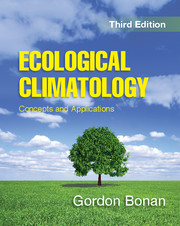Book contents
- Frontmatter
- Dedication
- Contents
- Preface
- 1 Ecosystems and Climate
- Part I The Earth System
- Part II Global Physical Climatology
- Part III Hydrometeorology
- 9 Soil Physics
- 10 Water Balance
- 11 Watershed Hydrology
- 12 Surface Energy Fluxes
- 13 Turbulent Fluxes
- 14 Soil Moisture and the Atmospheric Boundary Layer
- Part IV Biometeorology
- Part V Terrestrial Plant Ecology
- Part VI Terrestrial Forcings and Feedbacks
- Appendix
- Index
- Plate section
- References
10 - Water Balance
from Part III - Hydrometeorology
Published online by Cambridge University Press: 05 November 2015
- Frontmatter
- Dedication
- Contents
- Preface
- 1 Ecosystems and Climate
- Part I The Earth System
- Part II Global Physical Climatology
- Part III Hydrometeorology
- 9 Soil Physics
- 10 Water Balance
- 11 Watershed Hydrology
- 12 Surface Energy Fluxes
- 13 Turbulent Fluxes
- 14 Soil Moisture and the Atmospheric Boundary Layer
- Part IV Biometeorology
- Part V Terrestrial Plant Ecology
- Part VI Terrestrial Forcings and Feedbacks
- Appendix
- Index
- Plate section
- References
Summary
Chapter Summary
This chapter introduces the hydrologic cycle on land. The overall hydrologic cycle is reviewed and simplified into an expression where the change in soil moisture is the balance between precipitation input and losses from evapotranspiration and runoff. The various terms in this equation are discussed. Some precipitation is intercepted by the plant canopy and evaporates back to the atmosphere. Evaporation is the physical process by which liquid water changes to vapor. Transpiration is the evaporation of water held internal to plants as water moves from the soil through plants into the atmosphere along a continuum of decreasing water potential. The basic meteorological and biological processes controlling evapotranspiration are introduced, but Chapters 12 and 13 provide a more in-depth discussion of meteorological processes, and Chapters 15–17 review the biological control of transpiration by leaves and plant canopies. Runoff is discussed in separate sections on infiltration and overland flow. The section on overland flow reviews the effects of soil texture, soil water, and land cover on runoff. A simple model of the water balance illustrates geographic patterns of water availability.
Cycling of Water on Land
The cycling of water over land depicted in Figure 10.1 involves much more detail than that shown in Figure 3.4. Solar energy drives the hydrologic cycle, evaporating water from soil, lakes, and rivers. When conditions are favorable, this water vapor condenses to form clouds and eventually precipitation, which replenishes soil water and renews the cycle. Precipitation occurs when air cools and water vapor condenses to form cloud droplets or ice crystals. Cooling is caused by air rising in altitude, such as when air is lifted over mountains. This type of precipitation is known as orographic precipitation. Precipitation also occurs through frontal convergence, when a warm air mass rises over a colder air mass. In summer, thunderstorms develop when strong solar radiation heats the ground, warming the surface air and causing the less dense air to rise. This type of rainfall is known as convective precipitation.
Not all of the precipitation reaches the ground. Leaves, twigs, and branches of plants intercept rain and snow. Interception is the process by which precipitation is temporarily stored on plant surfaces. This water quickly evaporates and never replenishes the soil.
- Type
- Chapter
- Information
- Ecological ClimatologyConcepts and Applications, pp. 155 - 172Publisher: Cambridge University PressPrint publication year: 2015



